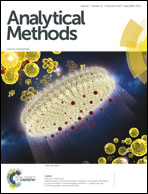Practical detection for simultaneous analysis of multiple antigens with Staphylococcal protein A as an intermediate
Abstract
Simultaneous measurements of multiple protein biomarkers are typically required to avoid false results in clinical diagnosis. In this work, we present an immunochemical event between antibody and antigen for simultaneous analysis of double biomarkers. In the presence of Staphylococcal protein A (SPA), two kinds of antibodies were captured on Ni–NTA agarose beads in a site-oriented model. Two target antigens and fluorescence-labeled antibodies were then added in turn to form an immunosorbent complex (antibody–antigen–antibody). The standard sandwich immunoassay can be visualized using a fluorescence microscope to detect the respective fluorescence-labeled antibodies bound to the bead's surface. Meanwhile, a freshly prepared gold-coated substrate was modified with 3-aminopropyl triethoxysilane (APTES) through a glutaraldehyde linker. The immunosorbent complex of the SPA–antibody–antigen was also validated in a quartz crystal microbalance (QCM) apparatus. The results showed an appreciable increase in frequency shift when the SPA, antibody, and antigen bound onto the chip, respectively. Qualitative synchronous fluorescence and quantitative QCM biosensors were practical methods for simultaneous detection of multiple serological antigen biomarkers.


 Please wait while we load your content...
Please wait while we load your content...